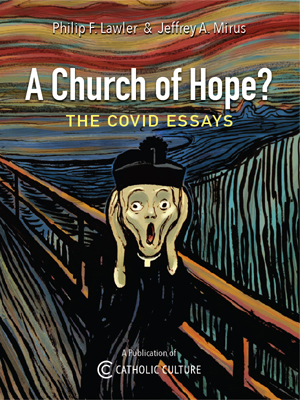Catholic Activity: All Souls, November 2
Detailed guidance from the General Instruction of the Roman Missal and other authoritative books for the ceremonies regarding the feast of All Souls.
DIRECTIONS
394. On the Commemoration of All the Faithful Departed the Church gathers in solemn suffrage for the souls in purgatory, and the liturgy should express this clearly. The color of the day is black or violet.1 If the commemoration falls on a Sunday, it is celebrated on that day and the propers for All Souls replace the Sunday texts.
395. A sense of sobriety and restraint should characterize All Souls Day. Flowers are not placed on or near the main altar, and the organ or other instruments are only used to sustain singing.2 It also seems preferable to use simpler candlesticks on or around the altar, as in Lent.3
396. On this day every priest may celebrate three Requiem Masses: (1) for a specific intention, (2) for all the faithful departed and (3) for the Holy Father's intentions. This privilege was granted by Pope Benedict XV in Incruentum altaris (1915) and has never been revoked. However, a celebrant may take a stipend for only one of the Masses. Furthermore, the timing of these Masses should respect the needs and working day of parishioners or the members of a religious community, which would not favor celebrating the three Masses one right after the other. A priest celebrating privately may choose to offer one Mass after the other, consuming the ablutions, which never break the eucharistic fast. Nevertheless, according to our current understanding of the liturgy, he may prefer to separate the celebrations of Mass across the day, or he may combine two celebrations and celebrate the third later in the day.
The celebrant may choose from the three Masses provided in the Roman Missal. According to the options available in the wide range of readings provided in the lectionary, the homily may well develop: our paschal hope of eternal life; the reality and meaning of purgatory; the propitiatory and impetratory nature of the Eucharistic Sacrifice; and the need to pray for the dead as an act of faith, hope and charity within the Body of Christ.4 The celebrant should also announce the indulgences granted on this day.5 In accord with the counsel offered to bishops,6 pastors should respect good popular customs associated with All Souls Day, such as the visit to the cemetery and the blessing of graves, setting up lights and flowers in the cemetery or in part of the church for the departed and the practices of burial societies or local sodalities dedicated to prayer for the Ho1y Souls.
The breviary recommends the public celebration of Lauds and/or Vespers on All Souls Day.7 As much as possible of the hour should be sung, preferably led by cantor(s) and choir. The celebrant wears a black or violet cope and stole over the alb or cassock and surplice. He should be assisted by a deacon or deacons, a lector, two candle bearers, a book bearer and a thurifer.8 It may he found more convenient to join the celebration of Lauds or Vespers to a Mass, either combining it with the rite of Mass37 or adding it to the Mass.9
The Visit to the Cemetery
399. In some places, it is customary to visit the cemetery to bless the graves of the faithful, even to celebrate Mass there, if this can be carried out with proper dignity and under suitable conditions. The Requiem Mass, Lauds, Vespers or a para-liturgy is followed by the sprinkling and incensing of burial sites. If the Liturgy of the Hours or a para-liturgy is celebrated, the celebrant may wear a black or violet cope and stole, over an alb or cassock and surplice. If the sprinkling and incensing immediately follows Mass, he may replace his chasuble with a cope, after the Prayer after Communion.
400. When this rite follows Mass, after the Prayer after Communion the celebrant gives a brief introduction to the rite. Then, he blesses incense at the chair, and, preceded by the thurifer, the cross and candle bearers, the holy water bearer and book bearer, the M.C. and deacon, he goes in procession to the place of burial while a suitable hymn is sung. Assisted by the deacon, M.C. or a server, he first sprinkles and then incenses the burial sites. If he wears a cope, this may be held back on each side by the deacon, M.C. or servers for the sake of convenience during the sprinkling and incensations.
401. Having returned to the altar, or the point where the sprinkling began, the celebrant then sings or says "Let us pray" and an appropriate prayer chosen from the Rite of Funerals, the hook bearer attending as usual.10 The blessing and dismissal follow. After a Mass, a solemn blessing would seem appropriate, such as that provided in the Roman Missal for Easter Season or nos. I, II, and IV for the Season of the Year. If the rite follows the Liturgy of the Hours or a paraliturgy, the dismissal may well be preceded by a blessing and/or the three familiar versicles and responses for the dead, "Requiem a ternam Bona eis ..." (Eternal rest grant unto them), etc.
Footnotes: 1. Wearing white on All Souls Day tends to make the liturgy a repetition of All Saints Day. However white would be appropriate in a culture where it is the color of mourning, for example, in Japan.
2. Cf. CB, no. 397.
3. In some places the custom of using unbleached wax candles is maintained, but setting up a false catafalque with a pall and candles is no longer permitted.
4. See CCC, nos.954-58, 988-1019, 1010-14, 1020-21, 1030-32, 1051-55.
5. The faithful who visit a church or cemetery to pray for the faithful departed, saying the Lord's Prayer and the Creed, may gain a plenary indulgence once only under the usual conditions: sacramental confession, Eucharistic Communion and prayer for the Pope's intentions. Through prayer, this indulgence may be given over to the Holy Souls. Enchiridion of Indulgences, revised edition, 1986, concession 67.
6. Cf. CB, no. 396.
7. The Office of Readings would also be appropriate as a public celebration on this day.
8. For details of the ceremonial of the Liturgy of the Hours, see CMRR nos. 718-41.
9. See CMRR, nos. 765-70.
10. See CMRR, nos. 771-73.
Activity Source: Ceremonies of the Liturgical Year According to the Modern Roman Rite by Msgr. Peter J. Elliott, Ignatius Press, San Francisco, 2002






